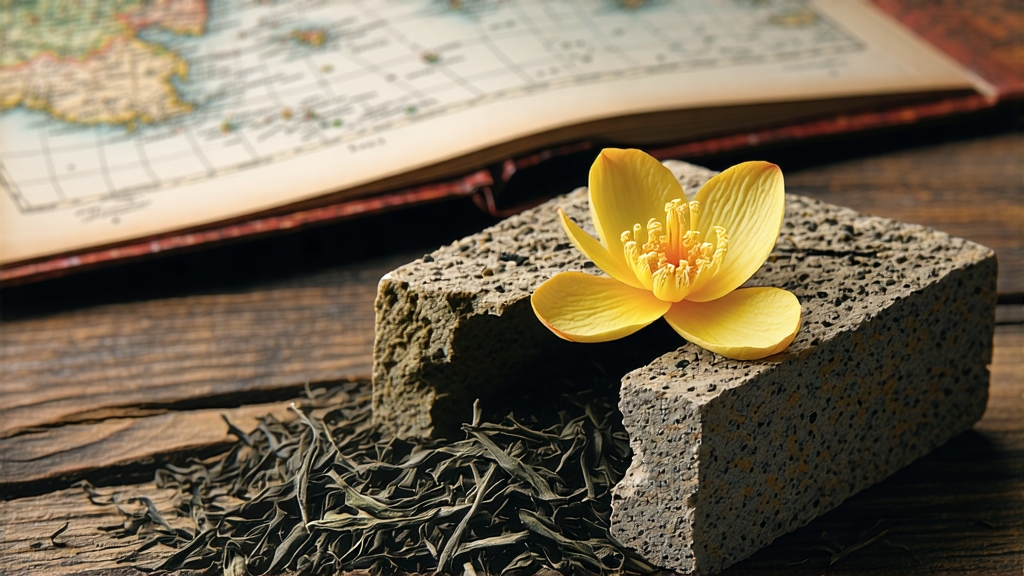
When most tea lovers outside China hear “dark tea,” they picture the malty depth of a Yunnan ripe pu-erh. Yet 1,200 km northeast of Kunming, in the humid loess highlands of Shaanxi, another dark tea has been quietly fermenting for six centuries. Called Fu brick—literally “Fu zhuan”—this compressed brick once served as currency along the camel caravans of the Silk Road and is still revered today for the tiny golden blossoms that bloom spontaneously inside its leaves. To understand Fu brick is to witness tea turning itself into probiotic medicine while still on the shelf.
History: From Frontier Fort to Global Curiosity
The story begins in the Ming dynasty (1368-1644) when the imperial court monopolized Sichuan and Hunan tea for its horse-for-tea barter system. Caravans heading west needed a tea that could survive six months of frost, desert heat and bandits. Tea masters in Jingyang county discovered that if they steamed loose Hunan maocha, packed it into 2 kg rectangular molds and allowed a secondary fermentation during the month-long trek, the bricks arrived in Lhasa and Kashgar darker, sweeter and strangely flecked with yellow. Tibetan nomads noticed the brew settled their stomachs after yak-butter meals, while Mongol traders found it eased the mutton-fat heaviness of winter. By the Qing era, “Jingyang Fu brick” had become the first intentionally inoculated tea in the world, predating the microbiology term “fermentation” by three centuries.
Microbial Magic: The Golden Flower
The yellow flecks are Eurotium cristatum, a harmless mold that Chinese call “golden flower” (jin hua). Unlike the broad microbial stew of pu-erh, Fu brick is a mono-culture miracle. After primary firing, the tea is re-wetted to 28 % moisture, stacked in 37 °C rooms for 7–10 days and ventilated so that spores drifting in the rafters land on the moist leaf. Within 48 hours the brick is freckled; within a week the mold has woven a golden web that exudes enzymes converting residual starch into sweet polyols and bitter catechins into mellow theabrownins. The result is a liquor that tastes of dried apricot, wet bark and a faint camphor coolness, with none of the fishy notes that sometimes haunt young shou pu-erh.
Craft: From Leaf to Brick
Fu brick starts life as summer-picked Hunan large-leaf varietal (Camellia sinensis var. assamica). Leaves are withered, pan-fired, rolled and sun-dried into rough maocha. Arriving at Jingyang, the tea is sifted to remove dust, then sprayed with 85 °C water until it feels like a wrung-out sponge. The damp leaf is steamed for 8 seconds to soften, poured into pinewood molds lined with cotton cloth and pressed under a 200-ton screw press for six minutes. Bricks are de-molded, stacked in fermentation rooms, turned twice daily to oxygenate, then dried in 55 °C ovens until moisture drops to 12 %. A single brick weighs 2 kg, measures 35 × 18 × 4 cm and bears the trademark “Jingyang” characters burned onto its face with a branding iron.
Aging: The Quiet Decade
Although drinkable after three months, Fu brick is a living entity. Stored below 75 % RH and 25 °C, the golden flowers continue to secrete enzymes that mellow tannins and generate gamma-aminobutyric acid (GABA), a calming neurotransmitter prized in functional foods. Ten-year bricks develop a ruby rim around the liquor and a scent reminiscent of antique Chinese medicine shops—sweet, earthy, slightly resinous. Unlike pu-erh, Fu brick rarely improves after fifteen years; the mold exhausts its substrate and the tea flattens.
Brewing: The Caravan Method vs. the Gongfu Way
Two schools exist. Silk-Road purists drop 10 g of broken flakes into a 1 L copper kettle, boil for three minutes, add yak butter and salt, then churn until frothy—an energizing 400-calorie breakfast. Modern gongfu aficionados favor a 120 ml porcelain gaiwan: 5 g of leaf, 100 °C water, flash rinse, then steep 10 s, 15 s, 20 s, adding five seconds each infusion. The first cup delivers a bright